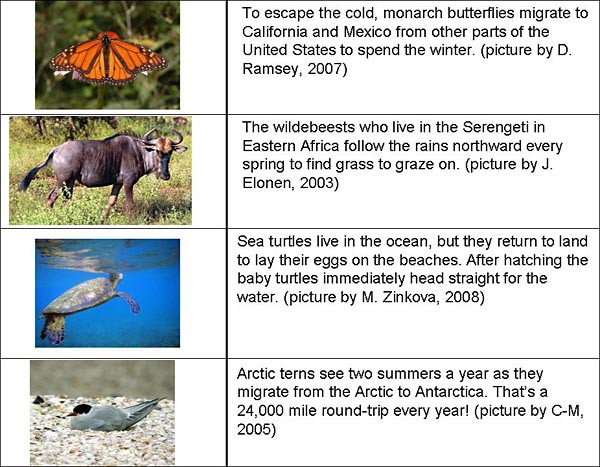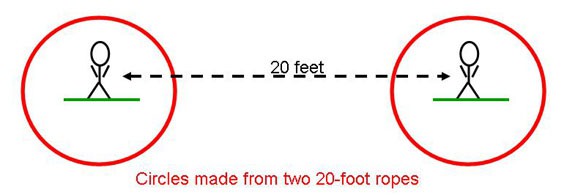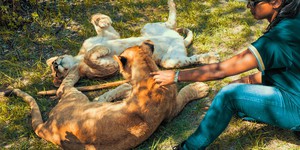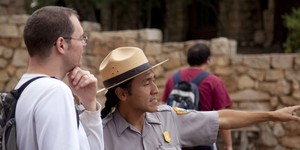Abstract
You might like to play in the autumn leaves and winter snow, but have you noticed that many birds don't like to stick around for the cold weather? And instead of the birds you're used to seeing in the warm months, your new feathered friends might be Canada geese. Why is that? Various types of birds and other animals travel from one place to another either in search of food, warmer temperatures, or other things they need to survive. This type of traveling is called migration. Try starting your own miniature bird migration in this science fair project!Summary
Melissa Bowlin, PhD
Martin Wikelski, PhD
Sandra Slutz, PhD, Science Buddies

Objective
Discover if birds will migrate (travel) a short distance when they run out of food.
Introduction
Have you ever noticed that some birds are only around during some parts of the year, while others stay all year long? For example, if you live in the eastern United States, you might have noticed that the ruby-throated hummingbirds all disappear for the winter, but return for summer and spring each year. Or maybe you've seen large flocks (groups) of Canada geese come spend the winters at your local ponds, but fly away again once spring arrives. This movement of animals from one place to another is called a migration.
It isn't only birds that migrate. Many different types of animals do, too! There are lots of reasons why an animal might migrate. Two of the most common reasons are food and temperature. If the temperature is getting too cold, an animal might choose to migrate somewhere where the temperatures are warmer so that they don't freeze. Animals also migrate when the local supply of food is too small to support the population. This is often the case with herds (groups) of antelope, buffalo, or other grass-eating mammals that move from one grassland to the next as they eat up all the available grass. In some cases, animals migrate in order to find a good place to hatch or raise their babies. Figure 1, below, shows some examples of migratory animals and why each of them makes their journey.
 Image Credit: Wikipedia / Free for common use
Image Credit: Wikipedia / Free for common useMonarch Butterflies migrate during the winter, wildebeasts in the Serengeti migrate with the rains to find grass to eat. Sea turtles move towards land to lay their eggs before returning back to sea, and arctic terns migrate from the north to south pole to avoid the harsh winters on either pole.
Figure 1. Many animals migrate. You can learn about a few of them from this table.
Some migrations take place over many days as the animals travel hundreds of miles. Others are shorter in both time and distance. In this science fair project, you'll see if you can create a miniature bird migration. You'll use food as a reason for the birds to migrate. With the help of some friends, you'll start out by feeding the birds in two locations. Then you'll see what happens when one of the locations runs out of food. Will the birds migrate from the location that doesn't have food to the one that does? Start the feeding frenzy and get ready to find out!
Terms and Concepts
- Flock
- Migration
- Herd
- Accuracy
- Average
- Trial
Questions
- Why do animals migrate?
- What kind of variations in frequency (how often something happens), duration (how long an event takes), and distance exist between different types of migration?
- Are there animals that migrate to or from the place where you live? When do they come and go, and why?
Bibliography
These websites will provide you with more information about animal migrations:
- ParkWise. (n.d.). Migration Basics. Retrieved October 24, 2008.
- BBC. (n.d.). World On the Move: Great Animal Migrations. Retrieved October 24, 2008.
For help creating graphs, try this website:
- National Center for Education Statistics. (n.d.). Create a Graph. Retrieved October 24, 2008.
Materials and Equipment
- Place where you can feed birds such as ducks, geese, pigeons, or seagulls. See the Experimental Procedure for more details.
- Bread (3 loaves)
- Plastic bags (2)
- Measuring tape, 20 feet long
- String or rope, 40 feet
- Scissors
- Volunteers (5, including you)
- Clipboards (2)
- Paper (2 sheets)
- Pens or pencils (2)
- Stopwatch
- Graph paper
- Lab notebook
Experimental Procedure
Finding a Place to Feed the Birds
To start this science fair project, you'll need to find a place where there are large groups of birds that you can feed bread to.
- Make sure to read any signs posted at the location. If the signs say "please do not feed the birds" then you'll need to find another place where bird feeding is allowed.
- There should be at least 15 birds at the location you choose.
-
Some possible places are:
- A pond or lake that has ducks or geese
- A park with pigeons
- A beach with seagulls
Preparing for the Experiment
- Before going to the bird-feeding location, tear one loaf of bread into chunks the size of a quarter coin.
- Put one-third of the chunks into one plastic bag, and the remaining two-thirds into the second plastic bag.
- Using the measuring tape and scissors, cut two pieces of string or rope, each 20 feet long.
Doing the Experiment
Two people will be in charge of feeding the birds, while two other people will count how many birds are around each bird-feeding station. And the fifth person will be in charge of using the stopwatch. It might be a good idea to ask the adult to be the one using the stopwatch.
- Have an adult take you and your volunteers (the adult can serve as one of the volunteers, too) to the bird-feeding location. Including you, there should be a total of five people to do this experiment. Be sure you have all the supplies you need, listed in the Materials and Equipment list, above.
-
Use the measuring tape to make sure the two people who are going to feed the birds are standing about 20 feet apart from one another.
- Try to position both bird-feeding people 10 feet or closer to the birds.
- The birds may run away from you as you set up the experiment. That's okay, they'll be back once you start offering them food.
- Make sure there are no other people nearby who are feeding the birds. If there are, they could affect your experiment, so you'll need to wait until they're done or move far away from them.
-
Use the pieces of string or rope you prepared to make a circle around each bird-feeding person. One bird-feeding person should stand in the middle of each circle. See Figure 2, below.
- Each bird-feeding person should hold a bag of bread chunks. The person holding the bag with one-third of the loaf of bread will be bird feeder #1, the person holding the bag with two-thirds of the loaf of bread will be bird feeder #2.
- The people who are going to be the bird counters should stand outside of the circles. Each bird feeder should be watched by one bird counter. Make sure the bird counters each have a good view of the bird feeder they'll be watching, as well as that person's entire circle.
- The bird counters should each have a clipboard with a data table on it, like the one below, and a pen or a pencil.
- The fifth volunteer should hold the stopwatch.
 Image Credit: Sandra Slutz, Science Buddies / Science Buddies
Image Credit: Sandra Slutz, Science Buddies / Science Buddies
Figure 2. The placement for the bird feeders and their feeding circles are shown in this diagram.
-
When everyone is in position and ready to begin, the person with the stopwatch should yell, "Go!" and start the stopwatch. The bird counters don't need to count any birds just yet.
-
Both bird feeders should start feeding the birds bread as soon as they hear the word "go."
- Feed the birds at a slow, but steady, pace.
- Try to have both bird feeders keep the same feeding pace. It may be a good idea to have the two bird feeders practice this side-by-side before the actual bird feeding begins (not at the park though, or your birds might start migrating before you're ready for them to!).
- Both bird feeders should make sure to throw the bread within the circle.
-
Both bird feeders should start feeding the birds bread as soon as they hear the word "go."
-
When the stopwatch reads 2 minutes, the person holding it should yell "Time!" and both bird counters should quickly count the number of birds in the circles and record the number in their data tables. Note: The bird feeders, should continue feeding.
- Bird counter #1 should count the number of birds in the circle around bird feeder #1.
- Bird counter #2 should count the number of birds in the circle around bird feeder #2.
- The bird counters should try to be as accurate as possible, but if there are birds moving in and out of the circle, it is okay if the final count is off by one or two birds.
- The person with the stopwatch should restart it again right after yelling "Time."
- Repeat step 5 every 2 minutes until bird feeder #1 runs out of bread.
-
When bird feeder #1 runs out of bread, he or she should yell "out of bread" and the person with the stopwatch should immediately reset the time.
- Bird feeder #2 should still have bread, because they started with twice as much bread as bird feeder #1 did. He or she should keep feeding the birds at the same pace as before.
- Bird feeder #1 should continue to stand in his or her circle, hands at his or her sides. He or she should still be holding the bag. If the birds were to get a hold of the bag, it could cause them harm.
- Now the stopwatch should be counting up from zero again and bird feeder #1 should be standing still inside his or her circle, bird counter #1 should still be watching and ready to count the birds inside circle #1, bird feeder #2 should still be feeding the birds, and bird counter #2 should be watching and ready to count the birds inside circle #2.
-
When the stopwatch reaches 2 minutes again, the person holding it should yell "Time!" and both bird counters should count the number of birds in the circles and record the number in their data sheets.
- Even though bird feeder #1 is out of food, bird counter #1 should still count how many birds are in bird feeder #1's circle.
- Bird counter #2 should count the number of birds in the circle around bird feeder #2.
-
Repeat step 9 every 2 minutes until bird feeder #2 also runs out of bread.
When Both Bird Feeders Have Bread: # of Birds in Circle at: Minute 2 Minute 4 Minute 6 Minute 8 Average Bird Feeder #1 Bird Feeder #2 When Only Bird Feeder #2 Has Bread: # of Birds in Circle at: Minute 2 Minute 4 Minute 6 Minute 8 Average Bird Feeder #1 Bird Feeder #2 - Repeat steps 1-10 two more times, either on different days at the same location or at different locations, but with the same type of bird.
Analyzing the Data
- Combine the data collected by both bird counters in one large data table in your lab notebook. Make a new table for each of the trials.
- With the help of an adult, calculate the average number of birds around each bird feeder before and after bird feeder #1 ran out of bread. Do this for each of the three times you did the experiment (each one is called a trial).
-
Using your graph paper, draw bar graphs of your data.
-
Make a bar showing the average number of birds around bird feeder #1 when he or she had bread, and a bar next to that when only bird feeder #2 had bread. Make two more bars for the averages for bird feeder #2.
- The bars should be as many squares high as the average number of birds. So if there where seven birds, on average, around bird feeder #1 when he or she had bread, the bar showing that data should be seven squares high.
- Label each bar so you know what it represents.
- Using the same method, make bar graphs for each trial. When you are done, you should have a total of three graphs.
- If you prefer to make your bar graphs on the computer, try using Create a Graph.
-
Make a bar showing the average number of birds around bird feeder #1 when he or she had bread, and a bar next to that when only bird feeder #2 had bread. Make two more bars for the averages for bird feeder #2.
- Look at your graphs. What happened to the number of birds around bird feeder #1 when the bread ran out? Did it increase, decrease, or stay the same? What about around bird feeder #2? When bird feeder #1's bread was gone, did the birds migrate to bird feeder #2?
-
Optional: How does the number of birds change in the circles of each bird feeder over time? Try answering this question by making a line graph showing all the data for each trial (use the counts for each time point, instead of the averages you calculated).
- Time should be on the x-axis and the number of birds around each feeder should be on the y-axis.
- In the end there should be three line graphs, one for each trial. Each line graph should have two lines—one for each bird feeder's data.
Ask an Expert
Global Connections
The United Nations Sustainable Development Goals (UNSDGs) are a blueprint to achieve a better and more sustainable future for all.
Variations
- Do different species of birds behave differently in this experiment? Find out by repeating this experiment with different types of birds.
- What happens if the bird feeders alternate feeding the birds. First, bird feeder #1 feeds them, but stops after a few minutes, just as bird feeder #2 starts, and then the cycle repeats. Will the birds keep migrating back and forth between the two feeders? Design an experiment to find out.
- What is the maximum distance you can put between the two bird feeders and still see a migration occur? Experiment to discover the answer.
Careers
If you like this project, you might enjoy exploring these related careers:









